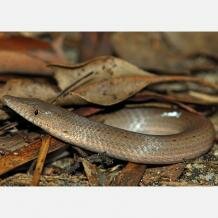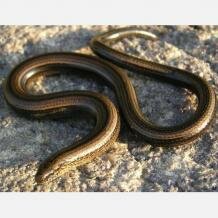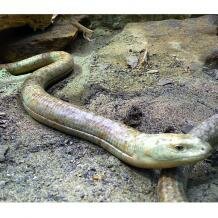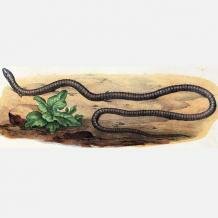Topic: Limblessness in lizards
What's that slithering towards you? A snake? Look more closely, look convergently...
Most living reptiles belong to the order Squamata, the ‘scaled reptiles’, which include snakes, lizards and amphisbaenians. The snakes, of course, lost their limbs millions of years ago, although the fossil record provides not much evidence of how and when this happened. Surely limblessness is one of the most obvious features distinguishing snakes from lizards? Not quite. Many groups of lizards have independently lost their limbs and effectively converted themselves into “honorary snakes”. There seem to be two recurrent ecomorphs – a short-tailed burrowing form (which has evolved more often) and a long-tailed surface-dwelling form, which tends to occur in dense vegetation (where limbs would be equally obstructive) and is often referred to as ‘grass-swimming’. Want to know more?
 Pygopodidae
Pygopodidae
This gecko family contains about 40 Australian and New Guinean species, which, as their common name ‘snake-lizards’ suggests, bear remarkable resemblance to snakes. They have lost their forelimbs and reduced their hind limbs to small flaps (the function of which is mysterious). Their bodies are also unusually elongate. Some species are burrowers, others grass swimmers. A particularly intriguing example is Burton’s legless lizard (Lialis burtonis), an ambush predator that specialises on skinks. Here, the convergences to the true snakes go much further than limblessness, including the manner it strikes and the way in which it avoids retaliation by its prey. Interestingly, another Lialis species (L. jicari) has evolved hinged teeth independently of the snakes.
Scincidae
 In this diverse family, limb reduction has evolved independently at least ten times, mainly in fossorial taxa. Examples include the worm-like Western burrowing skink Typhlacontias of Southern Africa and Janetascincus and Pamelascincus, which are endemic to the Seychelles. Fossorial skinks share other adaptations that make burrowing more effective, such as a fusion of skull elements and head scales. This high level of convergence makes it difficult to use morphological characters for inferring skink phylogeny. For example, in a molecular analysis, the limbless skink taxon Typhlosaurus turned out to be highly polyphyletic, including three different clades that are very similar in morphology. Such cryptic diversity is also prevalent in the South African genus Scelotes, which shows remarkable variation in limb and digit reduction. For example, both S. gronovii and S. kasneri lack forelimbs but differ in the number of digits on their hind limbs, with the former having just a single digit and the latter bearing two. It has been suggested that digits have been lost independently at least twice in Scelotes.
In this diverse family, limb reduction has evolved independently at least ten times, mainly in fossorial taxa. Examples include the worm-like Western burrowing skink Typhlacontias of Southern Africa and Janetascincus and Pamelascincus, which are endemic to the Seychelles. Fossorial skinks share other adaptations that make burrowing more effective, such as a fusion of skull elements and head scales. This high level of convergence makes it difficult to use morphological characters for inferring skink phylogeny. For example, in a molecular analysis, the limbless skink taxon Typhlosaurus turned out to be highly polyphyletic, including three different clades that are very similar in morphology. Such cryptic diversity is also prevalent in the South African genus Scelotes, which shows remarkable variation in limb and digit reduction. For example, both S. gronovii and S. kasneri lack forelimbs but differ in the number of digits on their hind limbs, with the former having just a single digit and the latter bearing two. It has been suggested that digits have been lost independently at least twice in Scelotes.
Anguidae

 This widely distributed family with more than 100 species includes the ‘slow worms’ and ‘glass snakes’, so called because they easily “break” (i.e. lose their tail). Here, limb loss has also occurred multiple times, with three of four subfamilies containing limbless, snake-like members. Limb loss is correlated with an elongation of the body as well as with a reduction in digit number. A hypothetical sequence of body elongation to limb reduction to digit loss had long been assumed, but was not confirmed in a comprehensive study on anguid body form evolution. Instead, this study has provided evidence that these morphological variables have gradually changed together. Although many anguids are fossorial, there is no consistent association between limb loss and burrowing in this group; many species are grass swimmers. An elongation of the body can be achieved in two ways – elongation of only the trunk (e.g. in Anniella) and elongation of trunk and tail (e.g. in Ophiodes).
This widely distributed family with more than 100 species includes the ‘slow worms’ and ‘glass snakes’, so called because they easily “break” (i.e. lose their tail). Here, limb loss has also occurred multiple times, with three of four subfamilies containing limbless, snake-like members. Limb loss is correlated with an elongation of the body as well as with a reduction in digit number. A hypothetical sequence of body elongation to limb reduction to digit loss had long been assumed, but was not confirmed in a comprehensive study on anguid body form evolution. Instead, this study has provided evidence that these morphological variables have gradually changed together. Although many anguids are fossorial, there is no consistent association between limb loss and burrowing in this group; many species are grass swimmers. An elongation of the body can be achieved in two ways – elongation of only the trunk (e.g. in Anniella) and elongation of trunk and tail (e.g. in Ophiodes).
Other examples
Limbless forms occur in many other lizard families. In the Gymnophthalmidae from South America, the burrowing ecomorph has evolved repeatedly. This large family exhibits great morphological and ecological diversity, including arboreal and semi-aquatic species.  The so-called ‘blind lizards’ in the family Dibamidae, which diverged early from the other squamates, have also basically lost their limbs in adaptation to burrowing. However, only females are completely limbless, whereas males have retained small, flap-like hind limbs. The geographic distribution of dibamids has attracted some attention, as the 20 species in the genus Dibamus are restricted to Asia, while one morphologically very similar species (Anelytropsis papillosus) is found in Mexico. A recent molecular analysis has provided evidence for long-distance dispersal from Asia to North America and, surprisingly, for a split of Dibamus into two deeply divergent clades, one of which is the sister taxon of Anelytropsis. The grass-swimming ecomorph has evolved independently at least twice in plated lizards of Sub-Saharan Africa, once in the cordylid genus Chamaesaura and once in Tetradactylus in the family Gerrhosauridae. The members of both these genera have reduced limbs and elongate trunks and tails.
The so-called ‘blind lizards’ in the family Dibamidae, which diverged early from the other squamates, have also basically lost their limbs in adaptation to burrowing. However, only females are completely limbless, whereas males have retained small, flap-like hind limbs. The geographic distribution of dibamids has attracted some attention, as the 20 species in the genus Dibamus are restricted to Asia, while one morphologically very similar species (Anelytropsis papillosus) is found in Mexico. A recent molecular analysis has provided evidence for long-distance dispersal from Asia to North America and, surprisingly, for a split of Dibamus into two deeply divergent clades, one of which is the sister taxon of Anelytropsis. The grass-swimming ecomorph has evolved independently at least twice in plated lizards of Sub-Saharan Africa, once in the cordylid genus Chamaesaura and once in Tetradactylus in the family Gerrhosauridae. The members of both these genera have reduced limbs and elongate trunks and tails.
Cite this web page
Map of Life - "Limblessness in lizards"
https://mapoflife.org/topics/topic_378_limblessness-in-lizards/
June 9, 2021

